Interested in off-grid living, or taking a trip to a region that doesn’t depend on a disinfected public water supply? In this guide, we’ve shared everything you need to know about off-grid water filtration and purification, including our top 18 methods for different situations.
📌 Key Takeaways:
- There are numerous methods of off-grid water purification and filtration, including boiling water, DIY distillation, using a survival filter, making your own filter from tree branches, and using water purification drops or tablets.
- Filtration involves physically trapping contaminants in a filter media, while purification involves eliminating contaminants and microorganisms to produce potable, pure water.
- Off-grid natural water sources to filter are lakes, streams, springs, reservoirs, rainwater, and old wells.
Table of Contents
- ✅ 11 Portable Off-Grid Water Filtration And Purification Solutions
- ✂️ 5 Homemade DIY Off-Grid Water Filtration And Purification Solutions
- 🏡 2 In-Line Off-Grid Water Filtration And Purification Solutions
- 🆚 Off-Grid Water Filtration Vs Purification
- 🚰 Off-Grid Sources of Water To Purify
- 🪣 How To Collect & Store Water Off The Grid
- 📝 Final Thoughts
- ❔ Off-Grid Water Filtration: FAQ
✅ 11 Portable Off-Grid Water Filtration And Purification Solutions
Got time to prepare in advance for an off-grid trip? These are the 11 best portable off-grid water purification and filtration solutions to bring with you.
1) Water Purification Tablets or Drops
Water disinfection tablets or drops are useful to have on hand when you take a trip in the wilderness.
You can find water disinfection tablets containing:
- Iodine
- Chlorine dioxide
- Sodium dichloroisocyanurate
- Tetraglycine hydroperiodide
To use purification tablets or drops, follow the manufacturer’s instructions to add a couple of drops to your water, or dissolve the tablets in your water. The water will need to sit for several minutes to allow the chemicals to take effect before drinking.
Water purification drops or tablets make water safe to drink by killing bacteria and other microorganisms, but they add small amounts of chemicals to your water in the process.
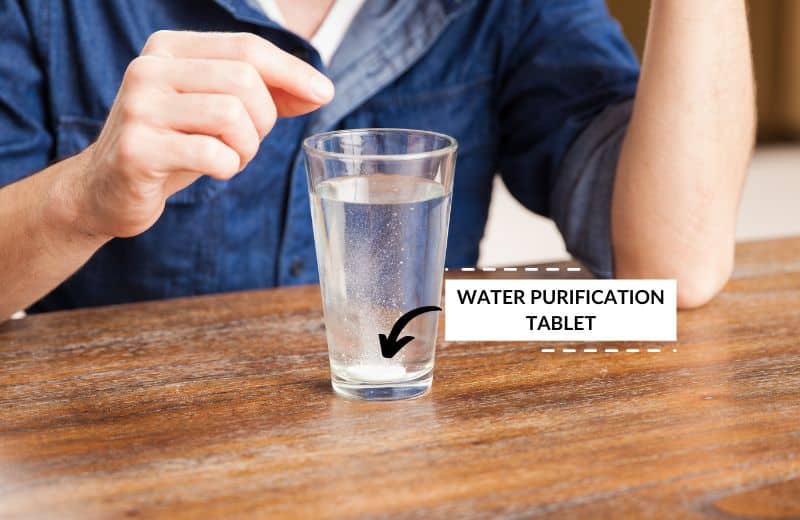
2) Pump Water Filters
A pump water filter uses pumping to force water through a filter element, removing contaminants and making it safe to drink.
There are several pump filters available in different sizes, from small, handheld pump filters that need to be manually pumped, to large pump filters that use electricity.
Most pump filters use ceramic filters combined with other filter media to remove contaminants as small as viruses and bacteria. Large pump filter systems may have multiple separate filter stages.
3) Straw Filters
Straw filters are small filters built into a straw device. To use a straw filter, you place the bottom of the straw into the water and suck through the other end. The sucking force will send water through the filter and into your mouth.
Straw filters improve water’s taste and smell and make it safe to drink by removing bacteria, viruses, microplastics, protozoans, sand, and dirt. Most straw filters are made from nanofilter media, which is small enough to trap tiny contaminants.
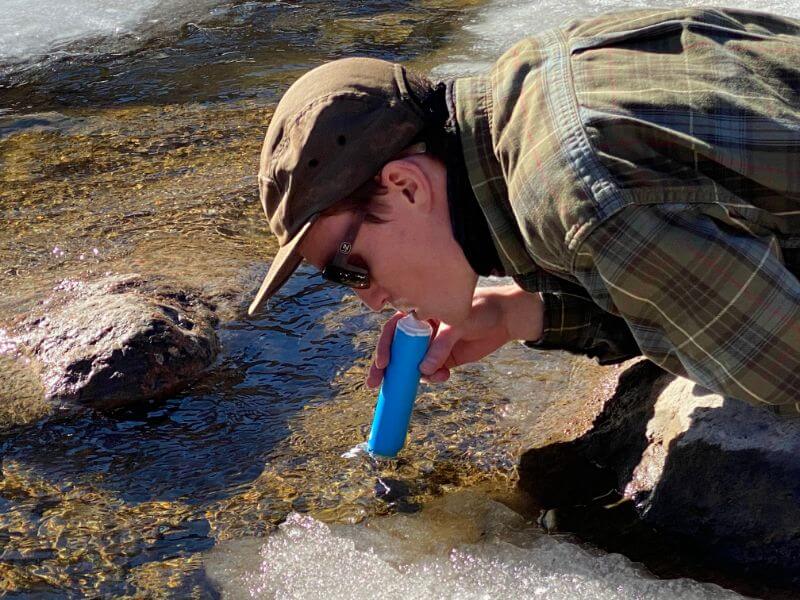
4) Countertop Water Filters
Countertop water filters are a portable option for camping and off-grid living.
These units are bigger than the other portable filters on this list, but they don’t need to be hooked up to a water supply or electricity, so they’re still suitable for transporting from location to location.
A countertop water filter has two separate chambers, one on top of the other. When you add water to the top chamber, it flows through a filter and into the bottom chamber, where it can be dispensed for drinking.
Most countertop water filters use ceramic filters combined with other filter media to remove chemicals, heavy metals, and microorganisms.
Here are some great countertop water filtration systems for off-grid use.
5) Water Bottle Filters
Water bottle filters are reusable water bottles that filter or purify water.
There are numerous types of water bottle filters available today, including push bottle filters (which filter water as you push the lid onto the bottle), straw bottle filters (which filter water as you suck through the straw), and UV bottle filters (which purify water with UV light when you tap the lid).
Depending on the type of filter, a water bottle filter can remove heavy metals, chlorine, and dirt, or kill bacteria, viruses, and other pathogens, in water.
Read our review of the best water bottle filters for off-grid living.
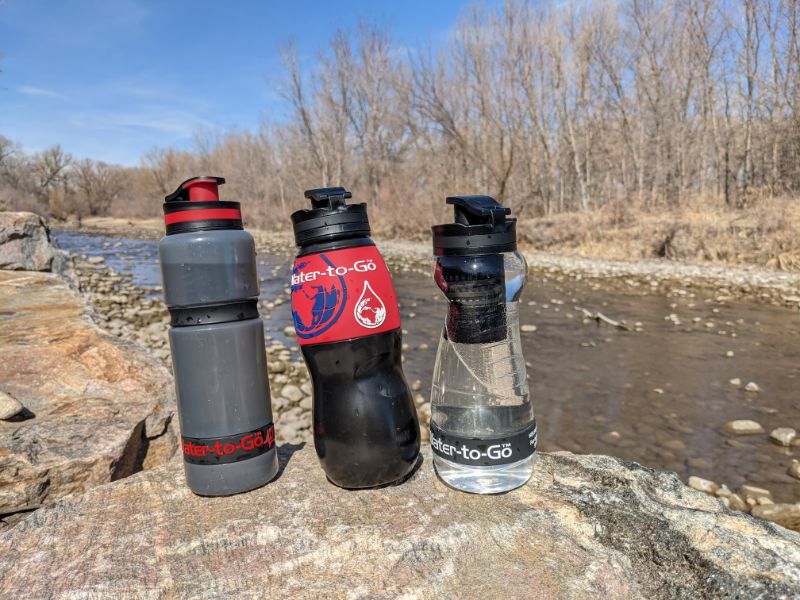
6) Water Pitcher Filters
Water pitcher filters are a small, gravity-fed type of water filtration system.
To use a water pitcher filter, add water to the pitcher lid, then wait for it to filter through the lid and into the chamber. Pour from the jug once enough water has been filtered.
📌 Most water pitcher filters are designed for treating city water, so they’re not usually suitable for purifying off-grid water (which often carries harmful microorganisms). However, some water pitcher filters designed for well water treatment contain nanofiltration media that can remove contaminants as small as bacteria and viruses.
7) Hanging Gravity Filters
Hanging gravity filters are another gravity-fed water filtration system. These filters are particularly popular amongst hiking and camping enthusiasts due to their small, lightweight design.
Simply add water to the dirty water bag and hang the bag up high. The water will flow through the filter and travel down a tube into a clean water bag (or your water bottle).
Most hanging gravity filters use a submircon filter that removes bacteria, cysts, microplastics, and sediment.
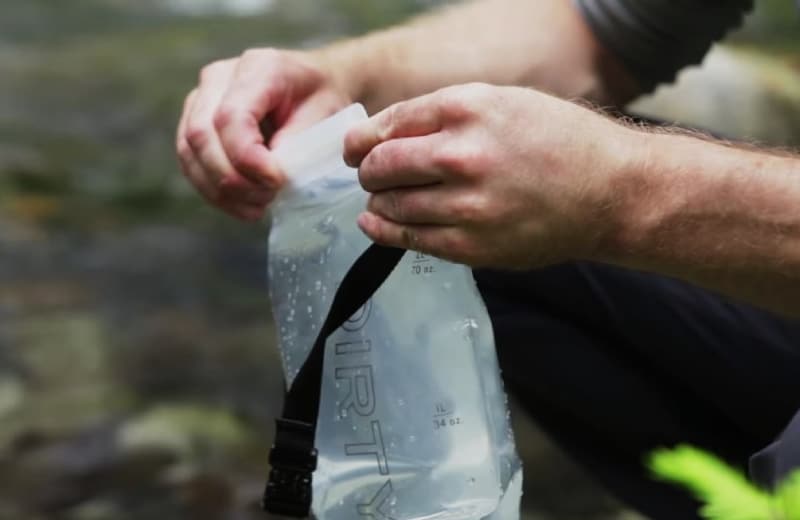
8) Chlorine Bleach
Another water disinfectant you could bring with you on an off-grid trip is chlorine bleach.
You’ll need about 2 drops of unscented liquid bleach for every quart of water you plan to disinfect. Murky water may need up to 4 drops of bleach per quart.
To disinfect water with chlorine bleach:
- Fill a container (with a lid) with water and add the appropriate amount of bleach
- Put the lid on the container and give it a shake
- After 30 minutes, open the lid
- If you can smell chlorine, the water should be disinfected and ready to drink
9) Calcium Hypochlorite
Calcium hypochlorite is another chemical that can be used to disinfect water in emergencies. This chemical is incredibly effective, so much so that it has the nickname “pool shock” for its ability to treat up to 10,000 gallons of water at once.
Make sure to buy a calcium hypochlorite product that contains at least 68% of this chemical. When not in use, keep the chemical in a cool, dark place, where it should last for up to a decade.
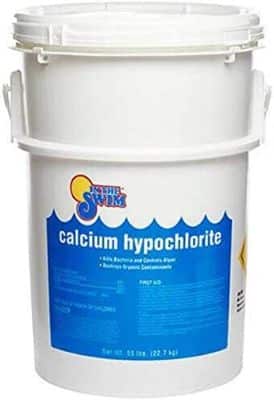
To clean your water with calcium hypochlorite:
- Follow the manufacturer’s instructions to add the right amount of the chemical to your water (usually 1 teaspoon for every 2 gallons).
- Wait for the chemical to dissolve and produce a chemical solution,
- Add this solution to your drinking water. The typical ratio is about 1:100, or 1 part solution to 100 parts water.
You can aerate the water by leaving it to sit out all night to reduce the chlorine taste and odor, or boil the water (if possible) for a faster solution.
10) Boiling
Boiling is one of the easiest off-grid methods of making water safe to drink. We’ve put boiling in the “portable” category because you can technically boil water anywhere, as long as you can build a campfire and you have a suitable pot for holding the water as it heats.
📌 To make water safe to drink by boiling, you should bring the water to a rolling boil for at least 1 minute (or 3 minutes if you’re elevated above 6,500 feet).
Boiling water kills microorganisms like bacteria and viruses, but it won’t physically filter the water, so you might need to combine this method with another one.
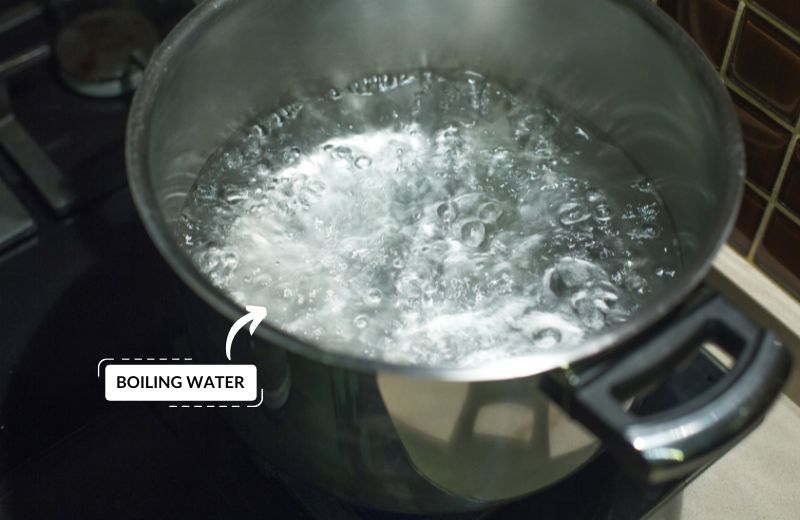
11) Shungite
Shungite is a natural water filter material that has shown to have good adsorption properties for certain contaminants, including heavy metals (like copper) and organic compounds.
Shungite stone is a rare material that can only be found in one country in the world: Russia.
If you happen to have Shungite in your pocket, you can use this material to filter water by adding several stones to a water bottle with the bottom cut off. Place the bottle over a clean container, pour water into the bottle, then wait for it to flow through the stones and into the container.
The issue with Shungite is that it releases various heavy metals and chemical elements into water, so it’s not the safest, cleanest method of water purification available today. Plus, your likelihood of stumbling across Shungite in the wild is zero – unless you happen to be hiking in Russia.
✂️ 5 Homemade DIY Off-Grid Water Filtration And Purification Solutions
Whether you’re in an emergency situation or you’re just trying to reduce your reliance on store-bought solutions, these 5 homemade off-grid water filters and purifiers should appeal to you.
12) Tree Branch Water Filters
Natural filtration takes place all around us in the environment, and MIT researchers found that pine sapwood has its own filtering process, removing air bubbles from tree sap to prevent tissue damage.
To make a DIY tree branch water filter:
- Gather several pine tree branches and peel off the bark
- Stick the branches into some plastic tubing and place a container underneath
- Pour water through the tubing. It’ll get filtered by the pine branches, which should remove impurities as small as 70 nanometers (such as bacteria and other pathogens).
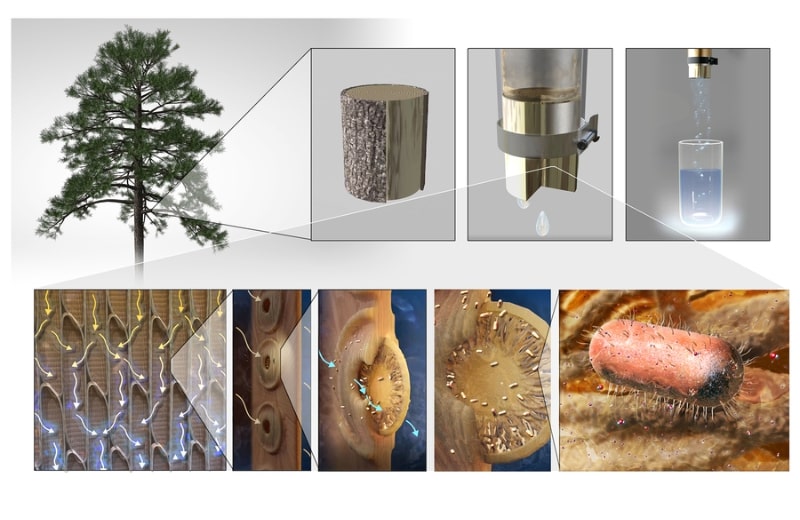
13) Homemade Activated Carbon Filters
You can also make a drinking water filter out of activated carbon. This filtration system will need some forethought since you’re unlikely to come across activated carbon in the wilderness.
You’ll need some cotton balls, activated carbon, sand (fine and coarse sand are best), some gravel (again, fine and large gravel will allow for the most thorough filtration), and a coffee filter to make a homemade activated carbon filter.
- Cut off the bottom of a clear plastic water bottle and turn the bottle upside down.
- From bottom to top, fill the bottle with a layer of cotton balls, activated carbon, fine sand, coarse sand, fine gravel, and then coarse gravel.
- Place the coffee filter at the top of the bottle.
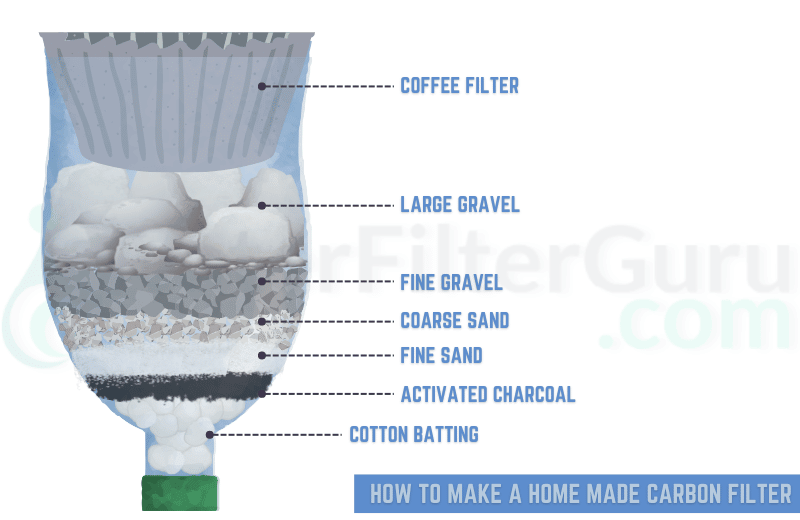
Place the bottle over an empty container, then pour water into the bottle. Water will flow through the separate filter stages and collect in the container underneath. Continue to add water to the bottle when the water level drops.
A homemade activated carbon water filtration system can improve water taste and odor and remove sediment and some heavy metals, but it can’t produce pure water.
14) SODIS
Solar water disinfection (or SODI for short) is one of the easiest methods of water disinfection using ultraviolet light from the sun.
Because SODIS is chemical-free and requires virtually no materials or resources, it’s suitable for emergency and off-grid use.
- Fill several water bottles (made from clear PET plastic) with water
- Leave them in full sunlight for at least 6 hours, preferably 24 hours
The ultraviolet light from the sun should kill most microorganisms.
Keep in mind that SODIS will only work when the sun is out, and it doesn’t work well in murky water because the turbidity will block the sun’s rays.
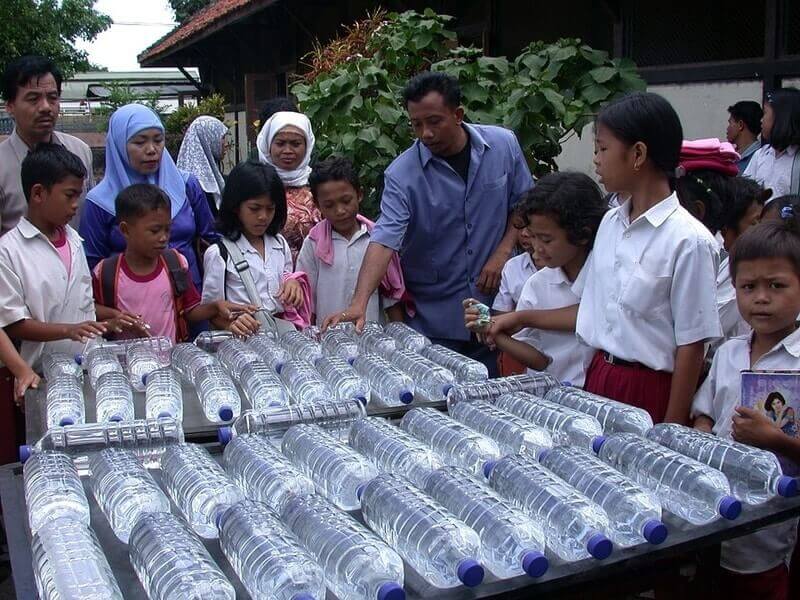
15) Ceramic Containers
If you happen to have a ceramic container (such as a ceramic flower pot) to hand, you can use this container to produce a homemade ceramic water filter.
- Stack the ceramic pot on top of a similarly sized pot made from a different material
- Make sure there is space between the stacked pots for water to collect in the bottom pot
- Pour water into the ceramic container
The water will gradually percolate through the pot material, where it’ll be collected in the second container. The ceramic materials are effective at removing bacteria, protozoans, tastes, odors, and turbidity, and may also reduce viruses – but they don’t remove dissolved chemicals.
16) DIY Water Distillers
This DIY water distiller method produces purer water than any other homemade water purification system – but it also takes the longest, and isn’t feasible for producing big batches of water.
To make your own water distiller:
- Dig a hole in the ground in a sunny spot and place an empty container inside.
- Stuff the space around the container with damp plants and leaves.
- Place a sheet of plastic (such as plastic wrap) over the hole and weigh down the middle with a stone.
As the sun heats up the earth, the moisture from the plants evaporates. The water vapor hits the underside of the plastic and condenses into the container.
Distilled water is virtually free from all impurities, including microorganisms, heavy metals, and chemical contaminants. However, DIY distillation takes hours, relies on access to damp plants and sunny weather, and doesn’t produce big batches of water, so it’s only really suitable as a last resort.
🏡 2 In-Line Off-Grid Water Filtration And Purification Solutions
These 2 water filtration and purification solutions are hooked up to your plumbing supply, providing convenient access to filtered water around your off-grid home.
17) Whole-Home Water Filtration Systems
There are numerous types of whole house water filters that are suitable for treating water containing heavy metals, nitrates, VOCs, chemicals, and other impurities and pollutants in surface water supplies.
A whole house system sends water through several stages of filtration, usually beginning with a sediment filter element. This unit is installed at the water line’s point of entry into your home, so it treats water before it flows through your hot water heater, pipes, and appliances.
These complex systems are best for homes that have a private well water source.
18) UV Purifiers
Most whole house water filters don’t kill or remove microorganisms, which makes them unsuitable for complete off-grid water treatment when they’re installed alone. Many whole house water filters are installed alongside UV bulbs, which use UV light to kill microorganisms.
When water flows through UV systems, the UV light emitted damages the DNA of bacteria and other pathogens, preventing them from replicating. UV bulbs offer the lowest-maintenance, lowest-hassle purification method.
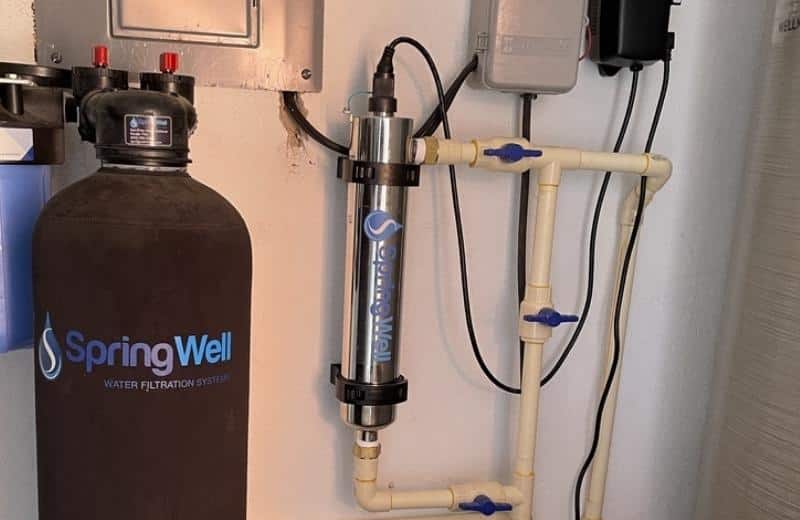
🆚 Off-Grid Water Filtration Vs Purification
Now you know the best filtration and purification methods for off-grid living, make sure you’re aware of the differences between water purification and filtration.
📌 Filtration involves physically removing debris, suspended solids, and dissolved particles from dirty water.
The filtration process improves the taste, smell, appearance, and overall quality of water. In off-grid applications, filtration is a necessary first step in removing visible cloudiness and murkiness from water. Common examples of off-grid filtration are straw filters and tree branch water filters.
📌 Purification is a much more thorough water treatment process that involves removing virtually all of water’s impurities, making it pure and completely safe to drink.
Purification can remove chemical contaminants and microorganisms like bacteria and viruses. Common examples of off-grid water purification are DIY distillation and whole home filtration systems with UV purification.
🚰 Off-Grid Sources of Water To Purify
It’s helpful to be aware of your surroundings if you’re traveling or living off-grid. Some of the possible water sources that you can purify in an off-grid setup are:
- Streams
- Lakes or reservoirs
- Rainwater
- Old wells (capped)
- Soil/plant moisture
- Springs
- Swamps
- Snow and ice caps
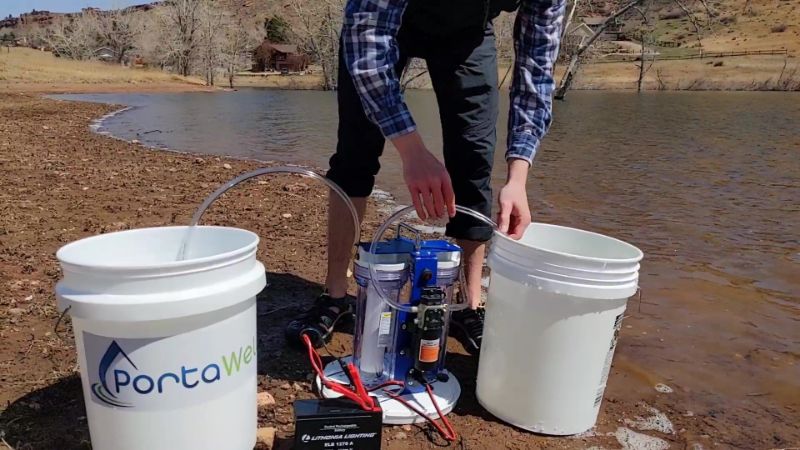
🪣 How To Collect & Store Water Off The Grid
If you’re planning to live off the grid and you want an easy way to collect and store water, the best option is a dedicated water storage container.
You can use a water storage container to collect rainwater above or below ground and deliver the water on demand to wherever it needs to be.
You can also use these tanks to simply store collected water for emergency uses – important in an off-grid living situation, when you don’t have access to a consistent, reliable water supply.
Rainwater isn’t pure water – it often contains impurities like PFAS, metals, chemicals, and other pollutants – so you’ll need to filter this water supply before using it for drinking.
Check out our best water storage containers guide for more information about your off-grid water storage options.
📝 Final Thoughts
If you live off-grid or you’re planning a hiking or camping trip in the wilderness, you can still access clean, purified water by using a water filtration system or water purification system.
Most off-grid filters and purifiers are gravity-fed or powered by a manual force (such as hand-pumping or sucking a straw), so they don’t need to be hooked up to a water supply, and they don’t require electricity to operate.
To keep costs low or to get by in an emergency situation, you can make your own water filter or purifier with just a few basic materials, such as pine branches and plastic water bottles. But if you want a more reliable, reassuring clean water solution, consider buying one of the many portable water filters available today.
❔ Off-Grid Water Filtration: FAQ
How do you filter rainwater for drinking off the grid?
There are numerous ways to filter rainwater for drinking off the grid, including using store-bought filters (such as straw filters, bottle filters, and hanging gravity filters), making your own filter out of activated carbon or pine branches, or distilling your water with a homemade water distiller.
Can you purify water without electricity?
Yes, you can purify water without electricity – but it’ll take a long time. At least, you can boil your water on a fire to kill bacteria and other pathogens. To completely purify your water, you can make your own DIY water distiller from a few basic items.
How do you purify water in the wild with nothing?
If you find yourself in the wild with no drinking water and no supplies, your last resort is to make an evaporation trap in the ground. Dig a hole in a sunny spot and place a container inside. Stuff moist plants around the outside of the container, then cover the hole with plastic and weigh it down in the middle. Wait for the sun to heat up the plants, causing the water to evaporate, hit the underside of the plastic, and condense into the container.
How can you filter water without a fire?
You can filter water without a fire by using a straw filter, a homemade tree filter or activated carbon filter, or with SODIS (place a PET bottle in direct sunlight for at least 6 hours).

